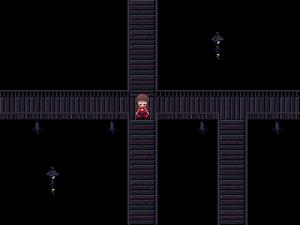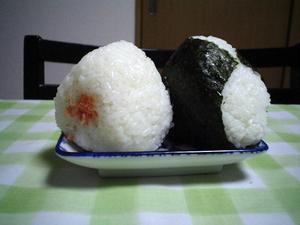>Mt.kiki No edit summary |
>Mt.kiki No edit summary |
||
| Line 106: | Line 106: | ||
==[[List_of_Characters#.28Unnamed.29|Sotoburu]]([http://en.wikipedia.org/wiki/Onigiri Onigiri])== | ==[[List_of_Characters#.28Unnamed.29|Sotoburu]]([http://en.wikipedia.org/wiki/Onigiri Onigiri])== | ||
※"Oni-kiri" and "O-nigiri(Rice ball)" is Japanese language Pun? | ※"Oni-kiri(Japanese sword)" and "O-nigiri(Rice ball)" is Japanese language Pun? | ||
O-nigiri <span style="font-weight: normal;">(お握り or 御握り; おにぎり<sup>[http://en.wikipedia.org/wiki/Help:Installing_Japanese_character_sets <span class="t_nihongo_icon" style="font: bold 80%/normal sans-serif; padding: 0px 0.1em; color: rgb(0, 0, 238); text-decoration: none; font-size-adjust: none; font-stretch: normal;"><u>?</u></span>]</sup>)</span>, also known as '''o-musubi''' <span style="font-weight: normal;">(お結び; おむすび<sup>[http://en.wikipedia.org/wiki/Help:Installing_Japanese_character_sets <span class="t_nihongo_icon" style="font: bold 80%/normal sans-serif; padding: 0px 0.1em; color: rgb(0, 0, 238); text-decoration: none; font-size-adjust: none; font-stretch: normal;"><u>?</u></span>]</sup>)</span> or '''rice ball''', is a [http://en.wikipedia.org/wiki/Japanese_cuisine <u>Japanese food</u>] made from [http://en.wikipedia.org/wiki/White_rice <u>white rice</u>] formed into triangular or oval shapes and often wrapped in ''[http://en.wikipedia.org/wiki/Nori <u>nori</u>]'' (seaweed). | O-nigiri <span style="font-weight: normal;">(お握り or 御握り; おにぎり<sup>[http://en.wikipedia.org/wiki/Help:Installing_Japanese_character_sets <span class="t_nihongo_icon" style="font: bold 80%/normal sans-serif; padding: 0px 0.1em; color: rgb(0, 0, 238); text-decoration: none; font-size-adjust: none; font-stretch: normal;"><u>?</u></span>]</sup>)</span>, also known as '''o-musubi''' <span style="font-weight: normal;">(お結び; おむすび<sup>[http://en.wikipedia.org/wiki/Help:Installing_Japanese_character_sets <span class="t_nihongo_icon" style="font: bold 80%/normal sans-serif; padding: 0px 0.1em; color: rgb(0, 0, 238); text-decoration: none; font-size-adjust: none; font-stretch: normal;"><u>?</u></span>]</sup>)</span> or '''rice ball''', is a [http://en.wikipedia.org/wiki/Japanese_cuisine <u>Japanese food</u>] made from [http://en.wikipedia.org/wiki/White_rice <u>white rice</u>] formed into triangular or oval shapes and often wrapped in ''[http://en.wikipedia.org/wiki/Nori <u>nori</u>]'' (seaweed). | ||
[[File:Onikiri-Maru(Tachi-sword).jpg|thumb|The late blade 2尺7寸9分2厘(85.4 cm) Heian period(794-1185/1192?) per minute,Kitano Tenman-gū possession.]] | [[File:Onikiri-Maru(Tachi-sword).jpg|thumb|The late blade of "鬼切(Onikiri)" 2尺7寸9分2厘(85.4 cm) Heian period(794-1185/1192?) per minute,Kitano Tenman-gū possession.]] | ||
橋姫の腕を斬った「鬚切」は実在し現存する[http://ja.wikipedia.org/wiki/%E6%97%A5%E6%9C%AC%E5%88%80 <u>日本刀</u>]で、この事件により「鬼切(おにきり)」と呼ばれるようになった。 | 橋姫の腕を斬った「鬚切」は実在し現存する[http://ja.wikipedia.org/wiki/%E6%97%A5%E6%9C%AC%E5%88%80 <u>日本刀</u>]で、この事件により「鬼切(おにきり)」と呼ばれるようになった。 | ||
Revision as of 05:35, 2 March 2013
The Docks(The maiden of the bridge)
Hashihime (橋姫?) ("the maiden of the bridge"[1]) is a character that first appeared in Japanese Heian-period literature, represented as a woman who spends lonely nights waiting for her lover to visit, and later as a fierce “oni” or demon fueled by jealousy. She came to be associated most often with a bridge in Uji.
Hashihime first appears in a Kokinshu (ca. 905) poem, of which the author is unknown:
- “Upon a narrow grass mat
- laying down her robe only
- tonight, again –
- she must be waiting for me,
- Hashihime of Uji”
Hashihime’s name also appears in Murasaki’s The Tale of Genji, as the title of a chapter. She is also mentioned several times in the waka poems throughout the work.
Sotoburu(Hashihime)
嫉妬に狂う鬼としての橋姫が現われるのは、『平家物語』の読み本系異本の『源平盛衰記』・『屋代本』などに収録されている「剣巻」で、橋姫の物語の多くの原型となっている。
橋姫 as a demon who goes mad in jealousy appears -- the reading this system of "Heike monogatari" -- it is "剣巻" recorded on "account of Genji-and-the-Heike rise and fall" - "Yashiro book" etc., and has become many prototypes of the tale of 橋姫. [ of a different book ]
大意は次の通り。(General meaning is as follows.)
嵯峨天皇の御世(809年-825年)、とある公卿の娘が深い妬みにとらわれ、貴船神社に7日間籠って「貴船大明神よ、私を生きながら鬼神に変えて下さい。妬ましい女を取り殺したいのです」と祈った。
Emperor Saga's world (809 years - 825 years) and a certain court noble's daughter are caught by deep jealousy, and Kibune-Jinja is filled for seven days -- "貴船 -- a great gracious god -- please change me into a fierce god, living. It was prayed that I would like to take and kill an envious woman."
明神は哀れに思い「本当に鬼になりたければ、姿を変えて宇治川に21日間浸れ」と告げた。
Myojin thought that he was sad and announced "If you would like to become a demon this [ this ], change a figure and be immersed in Uji-gawa for 21 days."
When the woman returned to the capital, in addition to the mouth, a total of five fire was burned for the torch which used hair as five angles by dividing into five,
put vermilion in the face, applied 丹(Red paints) to the body, made the whole body red,
鉄輪(てつわ、鉄の輪に三本脚が付いた台)を逆さに頭に載せ、3本の脚には松明を燃やし、さらに両端を燃やした松明を口にくわえ、計5つの火を灯した。
put at the head 鉄輪 (てつわ, stand to which 3 legs were attached to the iron ring) on reverse, and burned the torch on three foot, and also burned both ends.
綱はあわてず、鬚切で鬼の腕を断ち斬った。綱は北野の社に落ち、鬼は手を斬られたまま愛宕へ飛んでいった。
綱(Japanese name) is not panicked but had severed the demon's arm by 鬚切(Japanese sword).
綱 fell into the company in Kitano, and the demon flew to Atago, while the hand was cut.
綱が髪をつかんでいた鬼の腕を手に取って見ると、雪のように白かったはずが真っ黒で、
When 綱 took in its hand and looked at the arm of the demon grasping hair, although it was white like snow, it was deep-black in practice,
and as the silver needle was stood, white hair had grown closely.
※"Sotoburu" is Flashing "White"?
Sotoburu(Onigiri)
※"Oni-kiri(Japanese sword)" and "O-nigiri(Rice ball)" is Japanese language Pun?
O-nigiri (お握り or 御握り; おにぎり?), also known as o-musubi (お結び; おむすび?) or rice ball, is a Japanese food made from white rice formed into triangular or oval shapes and often wrapped in nori (seaweed).
橋姫の腕を斬った「鬚切」は実在し現存する日本刀で、この事件により「鬼切(おにきり)」と呼ばれるようになった。
"鬚切" which cut the arm of 橋姫(Hashihime) is a Japanese sword which exists really and is existing, and came to be called "鬼切;Demon-cutter(Oni-kiri)" by this incident.
綱の羅生門の鬼退治(『酒呑童子』)や多田満仲の戸隠山の鬼退治(『太平記』)などにも使われたとされる、鬼と縁が深い名刀である。
It is a celebrated sword with deep demon and edge which are said to have been used for the extermination of fiends ("酒呑童子") of Rashoumon Gate of 綱, the extermination of fiends ("Record of the Great Pacification") of Mt. Togakushi of the Tada 満仲, etc.
http://kitanotenmangu.or.jp/goyuisho/houmotu/
The Docks(Yukimi-dōrō )
3 Stone lanterns 3.2 Types of stone lantern 3.2.4 Yukimi-dōrō
Yukimi-dōrō (雪見燈籠?) or legged lanterns have as a base not a post but from one to six curved legs, and a wide umbrella with a finial either low or absent. Relatively low, they are used exclusively in gardens.[8] The traditional placement is near the water, and a three-legged lantern will often have two legs in the water, and one on land. The umbrella can be round or have from three to eight sides, while the fire box is usually hexagonal.
It was probably developed during the Momoyama period, but the oldest extant examples, found at the Katsura Villa in Kyoto, go back only to the early Edo period (seventeenth century).[8]







